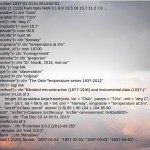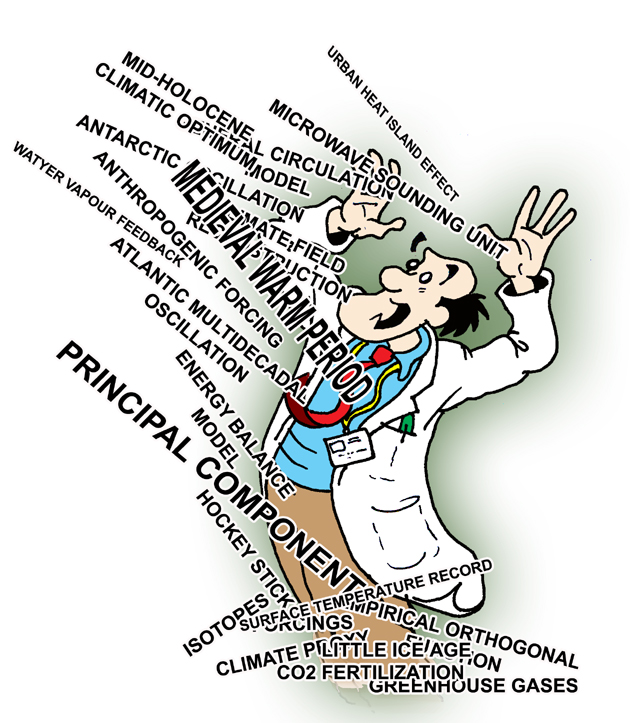 “These results are quite strange”, my colleague told me. He analysed some of the recent climate model results from an experiment known by the cryptic name ‘CMIP5‘. It turned out that the results were ok, but we had made an error when reading and processing the model output. The particular climate model that initially gave the strange results had used a different calendar set-up to the previous models we had examined.
“These results are quite strange”, my colleague told me. He analysed some of the recent climate model results from an experiment known by the cryptic name ‘CMIP5‘. It turned out that the results were ok, but we had made an error when reading and processing the model output. The particular climate model that initially gave the strange results had used a different calendar set-up to the previous models we had examined.
Glossary
Comprehensive climate glossary

But there are also a number of external web pages which provide climate-related glossaries, such as the NOAA (they also have a seperate page for paleo-stuff), the Bureau of Meteorology (Australia, and there is even one by the Australian EPA), the Environmental Protection Agency (EPA, the U.S.), and the Western Regional Climate Center (WRCC, the U.S.). Wikipedia also has a glossary for climatological terms.
For those who seek the explanation for more bureaucratic terms, both the EU and the UNFCCC provide glossaries that may be useful.
Furthermore, there are some nice resources available, such as the Encyclopedia of Earth.
Aerosol Aérosol
A collection of airborne solid or liquid particles, with a typical size between 0.01 and 10 µm and residing in the atmosphere for at least several hours. Aerosols may be of either natural or anthropogenic origin. Aerosols may influence climate in two ways: directly through scattering and absorbing radiation, and indirectly through acting as condensation nuclei for cloud formation or modifying the optical properties and lifetime of clouds (from the always useful IPCC glossary).
See-also: wiki:Aerosol.
Antarctic Oscillation (“AAO”) Oscillation Antarctique
Measure of the pressure gradient between the polar and subpolar regions of the Southern Hemisphere. Term was introduced by Thompson and Wallace (2000). More information on the AAO can be found here. See also Arctic Oscillation (“AO”).
Anthropogenic Forcing Forçage Anthropogénique
Forcing due to human, rather than natural, factors. Such factors include increased greenhouse gas concentrations associated with fossil fuel burning, sulphate aerosols produced as an industrial by-product, human-induced changes in land surface properties among other things.
Arctic Oscillation (“AO”) Oscillation Arctique
Measure of the pressure gradient between the polar and subpolar regions of the Northern Hemisphere. The term was introduced by Thompson and Wallace (2000). More information on the AO can be found here. See also North Atlantic Oscillation”(NAO”).
Atlantic Multidecadal Oscillation (“AMO”) Oscillation Atlantique Multi-Décennale (“AMO”)
A multidecadal (50-80 year timescale) pattern of North Atlantic ocean-atmosphere variability whose existence has been argued for based on statistical analyses of observational and proxy climate data, and coupled Atmosphere-Ocean General Circulation Model (“AOGCM”) simulations. This pattern is believed to describe some of the observed early 20th century (1920s-1930s) high-latitude Northern Hemisphere warming and some, but not all, of the high-latitude warming observed in the late 20th century. The term was introduced in a summary by Kerr (2000) of a study by Delworth and Mann (2000).
Atmosphere-Ocean General Circulation Model (“AOGCM”) Modèle Couplé Océan-Atmosphère de Circulation Générale (“AOGCM”)
Fully coupled atmosphere-ocean model of the three-dimensional global climate. See also ‘General Circulation Model (GCM)’.
Climate Field Reconstruction (“CFR”)
Approach to reconstructing a target large-scale climate field from predictors employing multivariate regression methods. CFR methods have been applied both to filling spatial gaps in early instrumental climate data sets, and to the problem of reconstructing past climate patterns from ‘climate proxy’ data.
Climate Proxy ‘Proxy’ ou marqueur climatique
Climate ‘proxies’ are sources of climate information from natural archives such as tree rings, ice cores, corals, lake and ocean sediments, tree pollen, or human archives such as historical records or diaries, which can be used to estimate climate conditions prior to the modern period (e.g. mid 19th century to date) during which widespread instrumental measurements are available. Proxy indicators typically must be calibrated against modern instrumental information to yield a quantitative reconstruction of past climate.